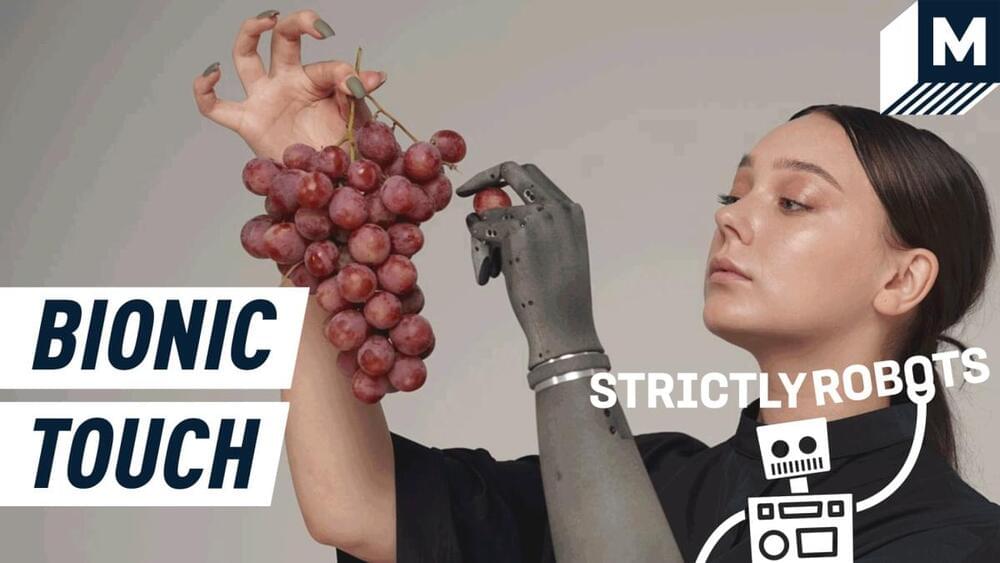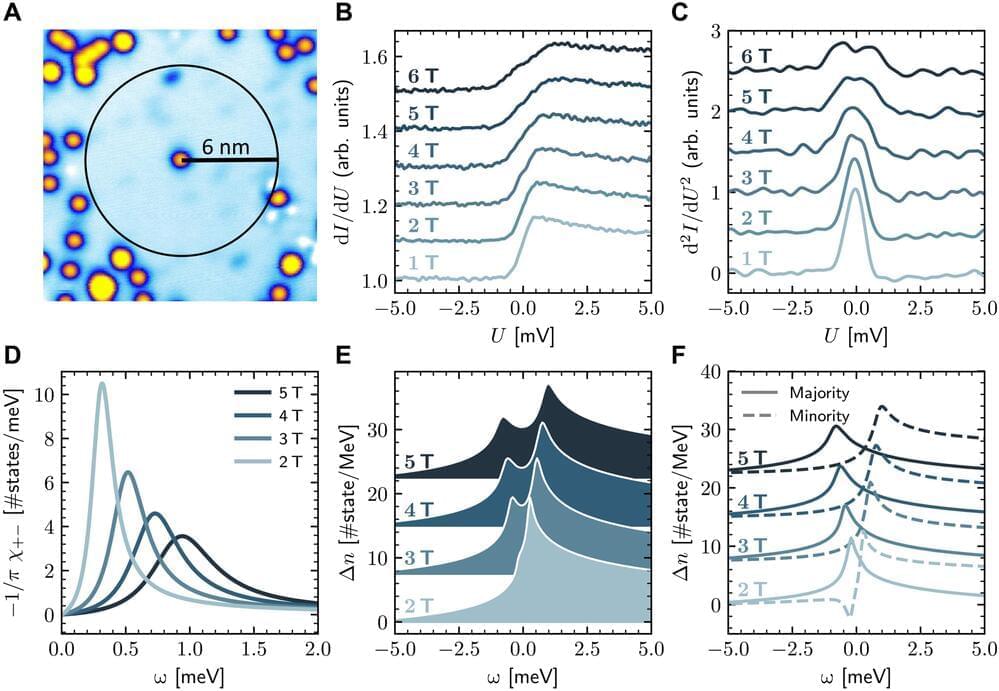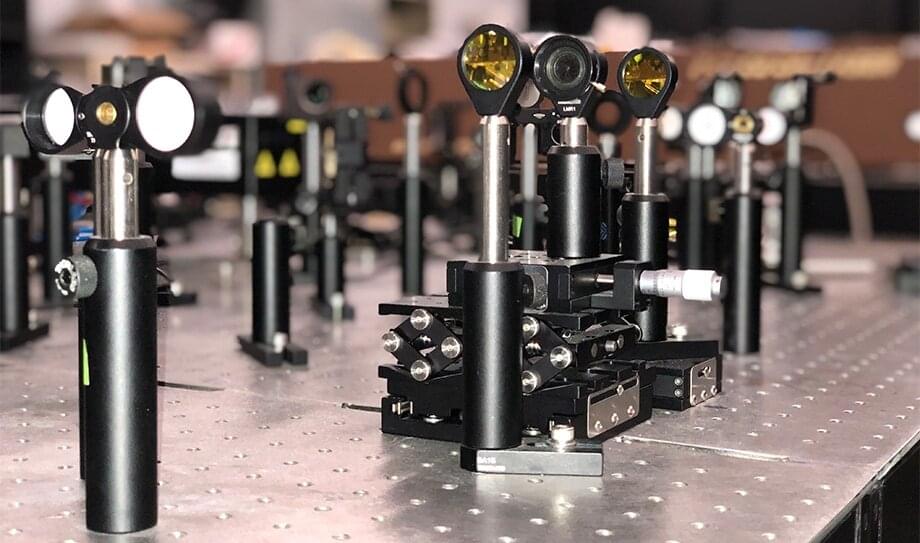It’s lighter than a human hand.
Quantum magnets can be studied using high-resolution spectroscopic studies to access magnetodynamic quantities including energy barriers, magnetic interactions, and lifetime of excited states. In a new report now published in Science Advances, Sascha Brinker and a team of scientists in advanced simulation and microstructure physics in Germany studied a previously unexplored flavor of low-energy spin excitation for quantum spins coupled to an electron bath. The team combined time-dependent and many-body perturbation theories and magnetic field-dependent tunneling spectra to identify magnetic states of the nanostructures and rationalized the results relative to ferromagnetic and antiferromagnetic interactions. The atomically crafted nanomagnets are appealing to explore electrically pumped spin systems.
Anomalous magnetodynamics
Magnetodynamics at the atomic scale form the cornerstone of spin-based nanoscale devices with applications in future information technologies. Interactions of local spin states also play a crucial role with the local environment to determine their properties. Researchers have described the impact of orbital hybridization effects, charge transfer, and the presence of nearby impurities as strong influencers on the magnetic ground state, to determine a range of magnetodynamic qualities, including magnetic anisotropy, spin lifetime and spin-relaxation mechanisms. Experimental methods can be developed to directly capture these properties and analyze the magnetic phenomena of classical and semiclassical descriptions at sub-nanometer scales to reveal the emergence of exquisite quantum mechanical effects.
The Standard Model of Cosmology describes how the universe came into being according to the view of most physicists. Researchers at the University of Bonn have now studied the evolution of galaxies within this model, finding considerable discrepancies with actual observations. The University of St. Andrews in Scotland and Charles University in the Czech Republic were also involved in the study. The results have now been published in the Astrophysical Journal.
Most galaxies visible from Earth resemble a flat disk with a thickened center. They are therefore similar to the sports equipment of a discus thrower. According to the Standard Model of Cosmology, however, such disks should form rather rarely. This is because in the model, every galaxy is surrounded by a halo of dark matter. This halo is invisible, but exerts a strong gravitational pull on nearby galaxies due to its mass. “That’s why we keep seeing galaxies merging with each other in the model universe,” explains Prof. Dr. Pavel Kroupa of the Helmholtz Institute for Radiation and Nuclear Physics at the University of Bonn.
This crash has two effects, the physicist explains: “First, the galaxies penetrate in the process, destroying the disk shape. Second, it reduces the angular momentum of the new galaxy created by the merger.” Put simply, this greatly decreases its rotational speed. The rotating motion normally ensures that the centrifugal forces acting during this process cause a new disk to form. However, if the angular momentum is too small, a new disk will not form at all.
Researchers at the U.S. Department of Energy’s (DOE) Princeton Plasma Physics Laboratory (PPPL) have gained insight into a fundamental process found throughout the universe. They discovered that the magnetic fields threading through plasma, the charged state of matter composed of free electrons and atomic nuclei, can affect the coming together and violent snapping apart of the plasma’s magnetic field lines. This insight could help scientists predict the occurrence of coronal mass ejections, enormous burps of plasma from the sun that could threaten satellites and electrical grids on Earth.
The scientists focused on the role of guide fields, magnetic fields threading through plasma blobs, or chunks, known as plasmoids. The guide fields add rigidity to the system and ultimately affect the ratio of large plasmoids to small ones and help determine how much reconnection occurs.
Plasmoid reconnection resembles the parallel computing that occurs in smart phones or in high-powered computers that model the weather. During this computing, many processors are calculating simultaneously and making the overall calculation rate quicker. Similarly, plasmoids speed up the overall rate of reconnection by making it occur in many places at once.
In collaboration with a team at the Federal Reserve Bank of Boston, MIT experts have begun designing and testing technical research through which further examination of a Central Bank Digital Currency (CBDC) can be performed in the U.S.
The effort, known as Project Hamilton, is in an exploratory phase, and the research is not intended as a pilot or for public deployment. Instead, the researchers have explored two different approaches that could be used to process transactions, and thus could indicate the technical feasibility of a potential CBDC model. In a process involving significant design flexibility, the MIT group tested factors such as the volume and speed of transactions, and the resilience of the systems in general, among other requirements for a viable digital currency.
“The core of what we built is a high-speed transaction processor for a centralized digital currency, to demonstrate the throughput, latency, and resilience of a system that could support a payment economy at the scale of the United States,” says Neha Narula, director of MIT’s Digital Currency Initiative and a research scientist at the MIT Media Lab, who led the effort with the Boston Fed. “It is important to note that this project is not a comment on whether or not the U.S. should issue a CBDC—but work like this is vital to help determine the answer to that question. This project serves as a platform for creating and comparing more viable designs, and provides a place to experiment and collaborate on more advanced digital currency functionality.”
A hundred years of physics tells us that collective atomic vibrations, called phonons, can behave like particles or waves. When they hit an interface between two materials, they can bounce off like a tennis ball. If the materials are thin and repeating, as in a superlattice, the phonons can jump between successive materials.
Now there is definitive, experimental proof that at the nanoscale, the notion of multiple thin materials with distinct vibrations no longer holds. If the materials are thin, their atoms arrange identically, so that their vibrations are similar and present everywhere. Such structural and vibrational coherency opens new avenues in materials design, which will lead to more energy efficient, low-power devices, novel material solutions to recycle and convert waste heat to electricity, and new ways to manipulate light with heat for advanced computing to power 6G wireless communication.
The discovery emerged from a long-term collaboration of scientists and engineers at seven universities and two U.S. Department of Energy national laboratories. Their paper, “Emergent Interface Vibrational Structure of Oxide Superlattices,” was published January 26 in Nature.
Texas Instruments revealed plans Thursday to invest $3.5 billion annually in its U.S. semiconductor chip manufacturing through 2025 as manufacturers face a global shortage of the tech necessary for an increasing number of goods.
The near-term investment figure marks a considerable uptick from the company’s capital expenditures in recent years. And from 2026 to 2030, the company said, it will continue investing in its manufacturing to the tune of 10% of annual revenue.
“It is increasingly clear that the secular growth of semiconductor content will continue for at least another 10 to 15 years,” the Dallas-based chipmaker’s chief executive, Rafael Lizardi, told analysts and investors during a presentation.
After NSO, another Israeli company, QuaDream, has been caught weaponizing iPhone bugs to deploy a spyware called Reign, similar to Pegasus.
A number of India-based call centers and their directors have been indicted for their alleged role in placing tens of millions of scam calls aimed at defrauding thousands of American consumers.
The indictment charged Manu Chawla, Sushil Sachdeva, Nitin Kumar Wadwani, Swarndeep Singh, Dinesh Manohar Sachdev, Gaje Singh Rathore, Sanket Modi, Rajiv Solanki and their respective call centers for conspiring with previously indicted VoIP provider E Sampark and its director, Guarav Gupta, to forward the calls to U.S. citizens.
“Criminal India-based call centers defraud U.S. residents, including the elderly, by misleading victims over the telephone utilizing scams such as Social Security and IRS impersonation as well as loan fraud,” the U.S. Justice Department said in a release.
Blockchain may one day eliminate inefficiencies and lack of transparency in supply chains. While slow in coming, this revolution would benefit not only customers and brands, but the invisible” workers who power global trade.
#Blockchain #SystemShock #BloomberQuicktake.
——-
Like this video? Subscribe: https://www.youtube.com/Bloomberg?sub_confirmation=1
Become a Quicktake Member for exclusive perks: https://www.youtube.com/bloomberg/join.
QuickTake Originals is Bloomberg’s official premium video channel. We bring you insights and analysis from business, science, and technology experts who are shaping our future. We’re home to Hello World, Giant Leap, Storylines, and the series powering CityLab, Bloomberg Businessweek, Bloomberg Green, and much more.
Subscribe for business news, but not as you’ve known it: exclusive interviews, fascinating profiles, data-driven analysis, and the latest in tech innovation from around the world.
Visit our partner channel QuickTake News for breaking global news and insight in an instant.








